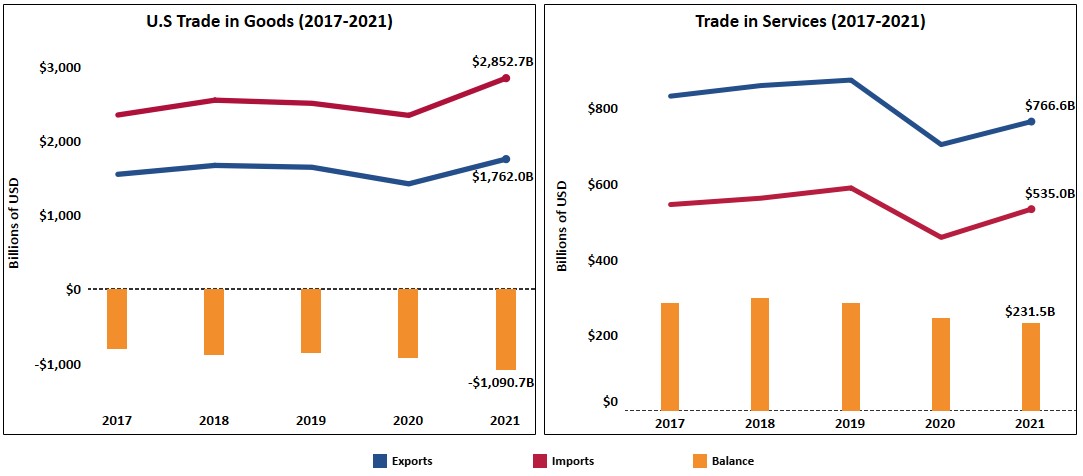U.S. Trade in 2021: U.S. Exporters on Road to Recovery
February 11, 2022
Anne Flatness, Eak Gautam, Amanda Reynolds and Ian Saccomanno are International Economists in the Office of Trade and Economic Analysis
Dig Deeper with ITA’s Data Tools
Still dominated by the COVID-19 pandemic, 2021 was a challenging but hopeful year for U.S. trade. The publication this week of last year’s trade data is a good opportunity to reflect on the remarkable resilience of U.S. exporters.
Overall, exports of goods and services in 2021 recovered to pre-pandemic levels, while imports exceeded theirs. Thanks to data from the Department of Commerce’s Bureau of Economic Analysis and U.S. Census Bureau, ITA can paint a larger story of how and where U.S. international trade recovered, and analyze what obstacles remain.
U.S. Trade in Goods and Services
Looking first at ITA’s annual trade infographic, we can see a divergence between goods and services trade. Goods trade includes physical products such as household products, cars, and food, while services trade includes economic activities such as financial services or transportation. Goods trade was strong across the board; exports and imports both reached new annual records, and all major export sectors were up from 2020. While services trade also increased, exports and imports of services continued to lag behind 2019 levels due to international travel. According to ITA’s National Travel and Tourism Office, both visitation to the United States and U.S. travel abroad increased from 2020 to 2021; however, travel has yet to return to pre-pandemic levels.
Deeper Dive: U.S. Goods Trade by Product
Amidst supply and demand shake-ups from COVID-19, as well as other shocks like the Texas winter storms and Hurricane Ida, trade disruptions were common in 2021. These disruptions had significant, at times divergent, impacts on major U.S. trade sectors. For example, looking across broad industries, we see that Transportation Equipment, which was the top export category for more than a decade, was displaced by Chemicals and Computer and Electronic Products in 2021.
An examination of the sub-industry detail in TradeStats Express reveals reasons for this shakeup. Transportation Equipment exports were hampered by the continued weakness of the Aerospace industry, mostly in civilian airplanes. The contrasting increase in Chemicals is mainly the result of rising Pharmaceutical and Medicine exports related to the pandemic, while the increase in Computers reflects increased Semiconductor exports, which are in high demand globally. Oil and Gas exports were also up sharply, driven by rising energy prices in 2021.
Imports show a similar shakeup. At the broad industry level, Computer & Electronic Products, which displaced Transportation Equipment as the top sector in 2020, retained that position in 2021 due to continued high demand for electronics as people worked and stayed at home. Primary Metals, which broke into the top 5 in 2020 as gold imports spiked, was displaced by Miscellaneous Manufactures in 2021 after gold demand moderated. Miscellaneous Manufactures includes Medical Equipment & Supplies such as Surgical Medical Instruments and Surgical Appliances & Supplies.
U.S. Goods Trade by Partner
U.S. goods trade with many partners recovered in 2021, meeting or exceeding pre-pandemic levels. On the export side, the U.S. set new records with 57 partners, including Mexico, China, South Korea and Germany. The top four U.S. goods export destinations remained unchanged in 2021, and all exceeded their 2019 export levels. Canada and Mexico continued to be the largest markets for the United States, followed by China and Japan.
Below these top four partners, however, relative rankings among U.S. partners varied. In 2021, South Korea passed the United Kingdom and Germany to become the United States’ fifth largest goods export market. Increased exports of Oil and Gas and Mechanical Machinery were the main reasons for this increase. In contrast, a lagging recovery in exports of Transportation Equipment hampered trade with the UK and Germany.
On the import side, while the top five partners did not change, there was significant movement outside the top five. Vietnam had exceptionally strong growth in recent years; between 2018 and 2021 its ranking among U.S. import partners rose from 12th to 6th. In addition to Vietnam, Taiwan and Malaysia have increased in relative import ranking. In all cases, trade with these partners has increased in sectors where we have seen declining trade from China, such as Computer and Electronic Products, Apparel, and Furniture. This is indicative of a broader trend of trade diversification away from China since 2018, where companies have reported that concerns including trade policies and the rising cost of labor have encouraged movement to new countries.
New Tool to Explore Annual and YTD Trade Data
You don’t have to be an economist to explore data yourself. Check out ITA’s recently modernized TradeStats Express (TSE), an interactive data visualization tool that industry researchers, policy analysts, and others can use to track trends in international trade at the national, state, product, and partner levels. Also, check out our Trade Data and Analysis tools page to learn about our other trade data research platforms. And don’t forget to bookmark our monthly trade analysis page for the most recent data releases!
